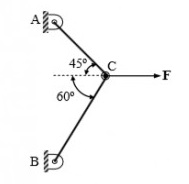Two steel truss members, AC and BC, each having cross sectional area of $100 mm^2$, are subjected to a horizontal force $F$ as shown in the figure. All the joints are hinged.

If $F=1$ kN. the magnitude of the vertical reaction force developed at the point B in kN is
- $0.63$
- $0.32$
- $1.26$
- $1.46$